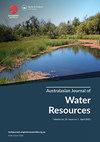涵洞堵塞的比例物理模型研究——探讨影响因素之间的复杂关系
IF 2.2
Q2 WATER RESOURCES
引用次数: 7
摘要
摘要据报道,卧龙岗和纽卡斯尔山洪暴发期间,交叉排水水工结构(如桥梁、涵洞)的堵塞是一个加剧因素。洪水事件数据的缺乏和洪水后数据的零碎性是阻碍研究堵塞对水工结构性能影响的因素。本文建议使用涵洞的比例物理模型进行实验室模拟,以研究城市和植被碎片的行为和影响。第一项调查研究了特定碎屑类型与涵洞进水口几何形状之间的相互作用及其对水力堵塞的影响。在第二次调查中,在实验室中模拟了洪水过程线,以研究堵塞相关影响因素之间的复杂关系,并将观察到的视觉堵塞和水力堵塞联系起来。根据第一次调查的结果,据报道,城市碎片是增加建筑物水力堵塞的主要原因。此外,发现水力堵塞的程度对碎屑的方向很敏感。第二次调查的结果报告了一些关于堵塞相关影响因素之间复杂关系的见解。从实验中观察到阻塞的时间变化性质,这些实验建议修改现有的基于恒定阻塞的澳大利亚降雨和径流(ARR)指南。本文章由计算机程序翻译,如有差异,请以英文原文为准。
A Scaled Physical Model Study of Culvert Blockage Exploring Complex Relationships Between Influential Factors
ABSTRACT Blockage of cross-drainage hydraulic structures (e.g., bridges, culverts) is reported as an exacerbating factor during flash flooding in Wollongong and Newcastle. Lack of data from flooding events and the fragmentary nature of post-flood data are the factors hindering research in studying the impact of blockage on the performance of hydraulic structures. This paper proposes lab-scale simulations using scaled physical models of culverts to study the behaviour and effects of urban and vegetative debris. The first investigation studies the interaction between specific debris types with culvert inlet geometries and their impact on the hydraulic blockage. In the second investigation, a flood hydrograph is simulated in the laboratory to study complex relationships between blockage-related influential factors and to relate the observed visual blockage and hydraulic blockage. From the results of first investigation, urban debris was reported the main contributor in increasing the hydraulic blockage at structures. Furthermore, the degree of hydraulic blockage was found sensitive to the orientation of the debris. Results from the second investigation reported several insights regarding the complex relationships between blockage-related influential factors. The temporally variable nature of blockage was observed from the experiments that suggested revising the existing constant blockage based Australian Rainfall and Runoff (ARR) guidelines.
求助全文
通过发布文献求助,成功后即可免费获取论文全文。
去求助
来源期刊

Australasian Journal of Water Resources
WATER RESOURCES-
CiteScore
5.10
自引率
21.90%
发文量
25
期刊介绍:
The Australasian Journal of Water Resources ( AJWR) is a multi-disciplinary regional journal dedicated to scholarship, professional practice and discussion on water resources planning, management and policy. Its primary geographic focus is on Australia, New Zealand and the Pacific Islands. Papers from outside this region will also be welcomed if they contribute to an understanding of water resources issues in the region. Such contributions could be due to innovations applicable to the Australasian water community, or where clear linkages between studies in other parts of the world are linked to important issues or water planning, management, development and policy challenges in Australasia. These could include papers on global issues where Australasian impacts are clearly identified.
 求助内容:
求助内容: 应助结果提醒方式:
应助结果提醒方式:


